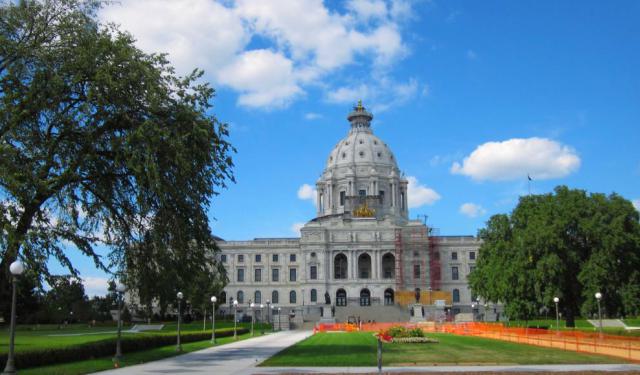Minnehaha Park, Minneapolis (must see)
The 53-foot waterfall-named for the Dakota words for “water” and “waterfall”-steals the spotlight at this beloved Minneapolis park, established way back in 1889. But it’s hardly the only reason to visit. Meander through the serene gardens of the upper park, or tackle the wilder terrain in the lower park if you’re up for a heartier hike.
If you’d rather explore on two wheels, rent a bike and check out the park’s historic gems: the Princess Depot, a petite transport museum; the John H. Stevens House, the first wood-frame home west of the Mississippi; and a replica of Longfellow’s home, where you can dig into the story behind Minneapolis’s expansive park system. For extra fun, there’s a disc golf course, a wading pool, and-drumroll-Sea Salt. Open from April to October, this seasonal hot spot serves up beachy bites like calamari, crab cakes, fried fish tacos, and oyster po’ boys. The lines are long, but the falls are gorgeous, so take in the view while you wait.
Flower lovers, take note: The Minnehaha Falls Pergola Garden is packed with stunning blooms and native plants (perfect for family photos) and the Song of Hiawatha Garden features a fountain brimming with colorful annuals. Meanwhile, Longfellow Gardens-once a zoo-boasts a replica of the poet’s house in Cambridge, Massachusetts. With so much beauty to explore, you might forget all about the waterfall. Almost.
If you’d rather explore on two wheels, rent a bike and check out the park’s historic gems: the Princess Depot, a petite transport museum; the John H. Stevens House, the first wood-frame home west of the Mississippi; and a replica of Longfellow’s home, where you can dig into the story behind Minneapolis’s expansive park system. For extra fun, there’s a disc golf course, a wading pool, and-drumroll-Sea Salt. Open from April to October, this seasonal hot spot serves up beachy bites like calamari, crab cakes, fried fish tacos, and oyster po’ boys. The lines are long, but the falls are gorgeous, so take in the view while you wait.
Flower lovers, take note: The Minnehaha Falls Pergola Garden is packed with stunning blooms and native plants (perfect for family photos) and the Song of Hiawatha Garden features a fountain brimming with colorful annuals. Meanwhile, Longfellow Gardens-once a zoo-boasts a replica of the poet’s house in Cambridge, Massachusetts. With so much beauty to explore, you might forget all about the waterfall. Almost.
Want to visit this sight? Check out these Self-Guided Walking Tours in Minneapolis. Alternatively, you can download the mobile app "GPSmyCity: Walks in 1K+ Cities" from Apple App Store or Google Play Store. The app turns your mobile device to a personal tour guide and it works offline, so no data plan is needed when traveling abroad.
Minnehaha Park on Map
Sight Name: Minnehaha Park
Sight Location: Minneapolis, USA (See walking tours in Minneapolis)
Sight Type: Park/Outdoor
Sight Location: Minneapolis, USA (See walking tours in Minneapolis)
Sight Type: Park/Outdoor
Walking Tours in Minneapolis, Minnesota
Create Your Own Walk in Minneapolis
Creating your own self-guided walk in Minneapolis is easy and fun. Choose the city attractions that you want to see and a walk route map will be created just for you. You can even set your hotel as the start point of the walk.
Saint Paul Introduction Walking Tour
Saint Paul is a fantastic example of a city that has grown through a diverse range of cultures. The location near the Mississippi River helped make what would later become the city a significant center of local trade. The Dakota Sioux tribe were among the earliest residents, and European settlement that included French-Canadian fur traders and Catholic missionaries occurred during the 1830s to... view more
Tour Duration: 2 Hour(s)
Travel Distance: 3.4 Km or 2.1 Miles
Tour Duration: 2 Hour(s)
Travel Distance: 3.4 Km or 2.1 Miles
University of Minnesota - Minneapolis Campus Walking Tour
Founded in 1851, seven years before Minnesota became a state, the University of Minnesota is one of the largest educational institutions in the United States. The university campus in the “Twin Cities” of Minneapolis and Saint Paul, spread along the bank of the Mississippi River, is a sprawling hub renowned for its rich academic environment and vibrant life.
One of the central gathering... view more
Tour Duration: 2 Hour(s)
Travel Distance: 2.9 Km or 1.8 Miles
One of the central gathering... view more
Tour Duration: 2 Hour(s)
Travel Distance: 2.9 Km or 1.8 Miles
Historical Churches
The "City of Lakes”, Minneapolis, doesn't pride itself solely on the lakes. In fact, you will be amazed by how many churches, cathedrals, and other places of worship are found throughout the city. These sacred structures have played a significant role in the development of Minneapolis and continue to serve as pillars of faith and community. Let's take a look at some of the most... view more
Tour Duration: 1 Hour(s)
Travel Distance: 2.8 Km or 1.7 Miles
Tour Duration: 1 Hour(s)
Travel Distance: 2.8 Km or 1.7 Miles
Minneapolis Introduction Walking Tour
Minneapolis is a major city in Minnesota, straddling the Mississippi River. Together with neighboring Saint Paul, the state capital of Minnesota, it forms the metropolitan area collectively known as the "Twin Cities."
Before European settlement, the site of Minneapolis was inhabited by Dakota people. The settlement was founded along Saint Anthony Falls - the only natural waterfall on... view more
Tour Duration: 2 Hour(s)
Travel Distance: 4.2 Km or 2.6 Miles
Before European settlement, the site of Minneapolis was inhabited by Dakota people. The settlement was founded along Saint Anthony Falls - the only natural waterfall on... view more
Tour Duration: 2 Hour(s)
Travel Distance: 4.2 Km or 2.6 Miles







